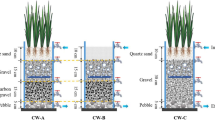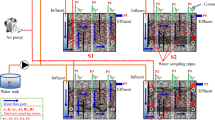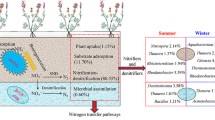Abstract
Sponge iron (s-Fe0) is a porous metal with the potential to be an electron donor for denitrification. This study aims to evaluate the feasibility of using s-Fe0 as the substrate of wetland mesocosms. Here, wetland mesocosms with the addition of s-Fe0 particles (CW-Fe) and a blank control group (CW-CK) were established. The NO3−-N reduction property and water quality parameters (pH, DO, and ORP) were examined at three COD/N ratios (0, 5, and 10). Results showed that the NO3−-N removal efficiencies were significantly increased by 6.6 to 58.9% in the presence of s-Fe0. NH4+-N was mainly produced by chemical denitrification, and approximately 50% of the NO3− -N was reduced to NH4+-N, at the COD/ratio of 0. An increase of the influent COD/N ratio resulted in lower ehermical denitrification and higher bio-denitrification. Although chemical denitrification mediated by s-Fe0 led to an accumulation of NH4+-N at COD/N ratios of 0 and 5, the TIN removal efficiencies increased by 4.5%–12.4%. Moreover, the effluent pH, DO, and ORP values showed a significant negative correlation with total Fe and Fe (II) (P < 0.01). High-throughput sequencing analysis indicated that Trichococcus (77.2%) was the most abundant microorganism in the CW-Fe mesocosm, while Thauera, Zoogloea, and Herbaspirillum were the primary denitrifying bacteria. The denitrifiers, Simplicispira, Dechloromonas, and Denitratisoma, were the dominant bacteria for CW-CK. This study provides a valuable method and an improved understanding of NO3−-N reduction characteristics of s-Fe0 in a wetland mesocosm.

Similar content being viewed by others
References
Adav S S, Lee D J, Lai J Y (2010). Enhanced biological denitrification of high concentration of nitrite with supplementary carbon source. Applied Microbiology and Biotechnology, 85(3): 7731–778
An Y, Li T, ** Z, Dong M, Li Q, Wang S (2009). Decreasing ammonium generation using hydrogenotrophic bacteria in the process of nitrate reduction by nanoscale zero-valent iron. Science of the Total Environment, 407(21): 5465–5470
Claus G, Kutzner H J (1985). Denitrification of nitrate and nitric acid with methanol as carbon source. Applied Microbiology and Biotechnology, 22(5): 378–381
Hao T, Li W, Lu H, Chui H, Mackey H R, van Loosdrecht M C, Chen G (2013). Characterization of sulfate-reducing granular sludge in the SANI(®) process. Water Research, 47(19): 7042–7052
Her J J, Huang J S (1995). Influences of carbon source and C/N ratio on nitrate/nitrite denitrification and carbon breakthrough. Bioresource Technology, 54(1): 45–51
Huang G, Liu F, Yang Y, Kong X, Li S, Zhang Y, Cao D (2015). Ammonium-nitrogen-contaminated groundwater remediation by a sequential three-zone permeable reactive barrier (multibarrier) with oxygen-releasing compound (ORC)/clinoptilolite/spongy iron: column studies. Environmental Science and Pollution Research International, 22(5): 3705–3714
Ilyas H, Masih I (2017). The performance of the intensified constructed wetlands for organic matter and nitrogen removal: A review. Journal of Environmental Management, 198(Pt 1): 372–383
Jiang C, Xu X, Megharaj M, Naidu R, Chen Z (2015). Inhibition or promotion of biodegradation of nitrate by Paracoccus sp. in the presence of nanoseale zero-valent iron. Science of the Total Environment, 530–531: 241–246
Ju Y, Liu X, Liu R, Li G, Wang X, Yang Y, Wei D, Fang J, Dionysiou D D (2015). Environmental application of millimeter-seale sponge iron (s-Fe0) particles (II): The effect of surface copper. Journal of Hazardous Materials, 287: 325–334
Khalil A M E, Eljamal O, Saha B B, Matsunaga N (2018). Performance of nanoscale zero-valent iron in nitrate reduction from water using a laboratory-seale eontinuous-flow system. Chemosphere, 197: 502–512
Lee D W, Lee S D (2008). Tessaracoccus flavescens sp. nov., isolated from marine sediment. International Journal of Systematic and Evolutionary Microbiology, 58(4): 785–789
Li B, Irvin S (2007). The comparison of alkalinity and ORP as indicators for nitrification and denitrifieation in a sequencing batch reactor (SBR). Biochemical Engineering Journal, 34(3): 248–255
Li J, Li J, Li Y (2009). Cadmium removal from wastewater by sponge iron sphere prepared by charcoal direct reduction. Journal of Environmental Sciences (China), 21(Suppl 1): S60–S64
Liu Y, Lowry G V (2006). Effect of particle age (Fe0 content) and solution pH on NZVI reactivity: H2 evolution and TCE dechlorination. Environmental Science & Technology, 40(19): 6085–6090
Mao Y, **a Y, Wang Z, Zhang T (2014). Reconstructing a Thauera genome from a hydrogenotrophic-denitrifying consortium using metagenomic sequence data. Applied Microbiology and Biotechnology, 98(15): 6885–6895
Mao Y, **a Y, Zhang T (2013). Characterization of Thauera-dominated hydrogen-oxidizing autotrophic denitrifying microbial communities by using high-throughput sequencing. Bioresource Technology, 128(1): 703–710
Mielcarek A, Rodziewicz J, Janczukowicz W, Dulski T, Ciesielski S, Thornton A (2016). Denitrifieation aided by waste beer in anaerobic sequencing batch biofilm reactor (AnSBBR). Ecological Engineering, 95: 384–389
Negri E D, Alfano O M, Chiovetta M G (1995). Moving-Bed Reactor Model for the direct reduction of hematite. Parametric study. Industrial & Engineering Chemistry Research, 34(12): 4266–4276
Nguyen N H A, Špánek R, Kasalieký V, Ribas D, Vlková D, Řeháková H, Kejzlar P, Ševeů A (2018). Different effects of nano-seale and micro-scale zero-valent iron particles on planktonic microorganisms from natural reservoir water. Environmental Science. Nano, 5(5): 1117–1129
Panda L, Das B, Rao D S, Mishra B K (2011). Application of doloehar in the removal of cadmium and hexavalent chromium ions from aqueous solutions. Journal of Hazardous Materials, 192(2): 822–831
Rahman M M, Roberts K L, Grace M R, Kessler A J, Cook P L M (2019). Role of organic carbon, nitrate and ferrous iron on the partitioning between denitrifieation and DNRA in constructed stormwater urban wetlands. Science of the Total Environment, 666: 608–617
Shin K H, Cha D K (2008). Microbial reduction of nitrate in the presence of nanoscale zero-valent iron. Chemosphere, 72(2): 257–262
Si Z, Song X, Wang Y, Cao X, Zhao Y, Wang B, Chen Y, Arefe A (2018). Intensified heterotrophic denitrifieation in constructed wetlands using four solid earbon sources: Denitrifieation efficiency and bacterial community structure. Bioresource Technology, 267: 416–425
Tosco T, Petrangeli Papini M, Cruz Viggi C, Sethi R. (2014). Nanoscale zerovalent iron particles for groundwater remediation: A review. Journal of Cleaner Production, 77: 10–21
Vymazal J (2007). Removal of nutrients in various types of constructed wetlands. Science of the Total Environment, 380(1–3): 48–65
Wang G, Wang Y, Guo Y, Peng D (2017). Effects of four different phosphorus-loeking materials on sediment and water quality in **’an moat. Environmental Science and Pollution Research International, 24(1): 264–274
Wang G B, Wang Y, Zhang Y (2018). Combination effect of sponge iron and calcium nitrate on severely eutrophic urban landscape water: An integrated study from laboratory to fields. Environmental Science and Pollution Research International, 25(9): 8350–8363
Yi Z, Xu J, Chen M, Li W, Yao J, Chen H, Wang F (2013). Removal of uranium(VI) from aqueous solution using sponge iron. Journal of Radioanalytical and Nuclear Chemistry, 298(2): 955–961
Zhang Y, Douglas G B, Pu L, Zhao Q, Tang Y, Xu W, Luo B, Hong W, Cui L, Ye Z (2017). Zero-valent iron-facilitated reduction of nitrate: Chemical kinetics and reaction pathways. Science of the Total Environment, 598: 1140–1150
Zhao Y, Cao X, Song X, Zhao Z, Wang Y, Si Z, Lin F, Chen Y, Zhang Y (2018). Montmorillonite supported nanoscale zero-valent iron immobilized in sodium alginate (SA/Mt-NZVI) enhanced the nitrogen removal in vertical flow constructed wetlands (VFCWs). Bioresource Technology, 267: 608–617
Zhen Z, Qiao W, **ng C, Ying A, Shen X, Ren W, Jiang L M, Wang L (2015). Microbial community structure of anoxie—oxie-settlinganaerobic sludge reduction process revealed by 454-pyrosequencing. Chemical Engineering Journal, 266(12): 249–257
Zhong Y, Yang Q, Fu G, Xu Y, Cheng Y, Chen C, **ang R, Wen T, Li X, Zeng G (2018). Denitrifying microbial community with the ability to bromate reduction in a rotating biofilm-eleetrode reactor. Journal of Hazardous Materials, 342: 150–157
Zhou J, Wang H, Yang K, Ji B, Chen D, Zhang H, Sun Y, Tian J (2016). Autotrophic denitrifieation by nitrate-dependent Fe(II) oxidation in a continuous up-flow biofilter. Bioproeess and Biosystems Engineering, 39(2): 277–284
Acknowledgements
This work was supported by the the National Natural Science Foundation of China (Grant Nos. 51679041 and 51909034); the Fundamental Research Funds for the Central Universities (Grant Nos. 2232019D3-21 and 2232018D3-22); the China Postdoctoral Science Foundation (No. 2018M641894); the Fundamental Research Funds for the Central Universities and Graduate Student Innovation Fund of Donghua University (Nos. CUSF-DH-D-2019079 and CUSF-DH-D-2019080); Shanghai Sailing Program (No. 19YF1401900); Shanghai Rising-Star Program (No. 19QC1401100).
Author information
Authors and Affiliations
Corresponding authors
Additional information
Highlights
• CW-Fe allowed a high-performance of NO3−-N removal at the COD/N ratio of 0.
• Higher COD/N resulted in lower chem-denitrification and higher bio-denitrification.
• The application of s-Fe0 contributed to TIN removal in wetland mesocosm.
• s-Fe0 changed the main denitrifiers in wetland mesocosm.
Rights and permissions
About this article
Cite this article
Si, Z., Song, X., Cao, X. et al. Nitrate removal to its fate in wetland mesocosm filled with sponge iron: Impact of influent COD/N ratio. Front. Environ. Sci. Eng. 14, 4 (2020). https://doi.org/10.1007/s11783-019-1183-7
Received:
Revised:
Accepted:
Published:
DOI: https://doi.org/10.1007/s11783-019-1183-7




